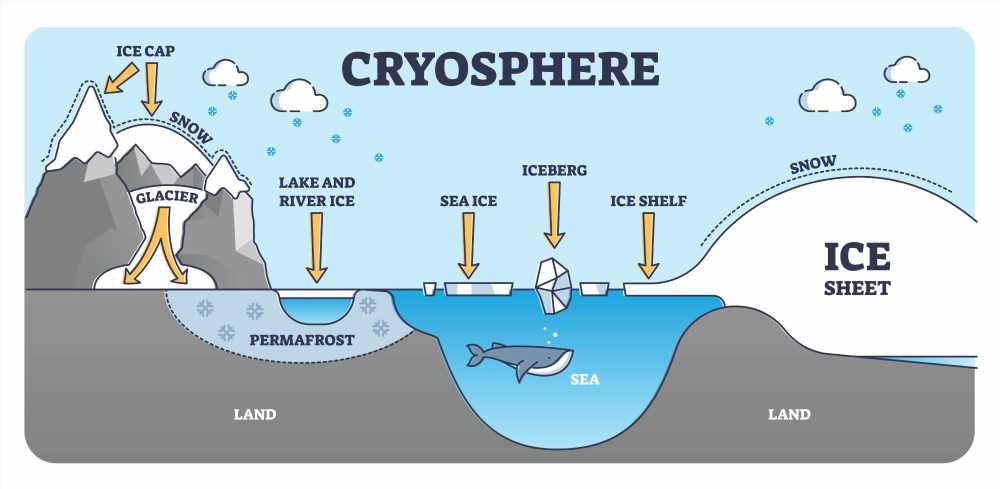Introduction
What challenges do microorganisms face within the cryosphere?
How are microorganisms adapted to niches within the cryosphere?
Studying microorganisms within the cryosphere
References
Cryosphere refers to any region of the Earth that is frozen, most prominently glaciers, icebergs, and permafrost, including surface frozen lakes and rivers as well as the seasonally frozen ground. Microbial activity is extremely active within the cryosphere, and microorganisms living here have adapted to fulfill a full range of ecological functions.

Image Credit: VectorMine/Shutterstock.com
What challenges do microorganisms face within the cryosphere?
Metabolic activity is slowed at low temperatures, though microbial reproduction has been reported at temperatures down to -20⁰C and ongoing metabolic activity at -30⁰C. One of the main issues facing microorganisms at this temperature is the vitrification of fluids, where dehydration and cold temperatures produce extreme internal viscosity, preventing biomolecules from freely moving and interacting. In this case, however, microorganisms can recover once warmed and rehydrated, as long as ice crystals have not damaged essential cellular components such as the cell membrane.
Microorganisms adapted to the cryosphere frequently demonstrate upregulated cell membrane and cell envelope biogenesis, as well as increased expression of proteins related to membrane fluidity, nutrient transport, and cryoprotection compared to those populating warmer climates. On the other hand, genes related to the expression of extracellular structures, such as flagella or those involved in reactive oxygen species production, are down-regulated.
In solid form as ice or snow, water is not available to microorganisms, though, within the porous structure of ice sheets and snow blankets, water exists in liquid form and can be utilized. When operating in freezing conditions, the possibility of ice crystals forming within a microorganism poses a danger, as they could potentially destroy the cell membrane. Microorganisms adapted to living within the cryosphere possess more flexible membranes and other cellular components that are less easily damaged by ice crystals, also allowing enzymes and other proteins to maintain functionality in freezing conditions.
Anti-freeze proteins and extracellular glycans have also evolved amongst some microorganisms, which act to prevent ice crystal formation. The concentration of water and nutrients may vary significantly amongst different niche habitats. For example, the porous structure of an iceberg contains more water than a glacier; thus, microorganisms adapted to these environments have evolved various mechanisms of osmotic regulation that may be specific to their niche.
How are microorganisms adapted to niches within the cryosphere?
Around 70% of the Earth’s freshwater is locked in glaciers, which form by the constant compaction of snow falling on land over hundreds or thousands of years. The upper meter or so of glaciers are largely populated by microorganisms from the air, which settle and colonize to form distinct communities. Clean, fresh surface ice hosts a relatively low microbial population, though as dust and other mineral particulates build up on the surface, then albedo drops, and the ice begins to absorb more heat from the sun, melting slightly and forming pits that are more readily populated by microorganisms, known as cryoconite holes.
Algae and microorganisms that produce organic sediment further lower ice reflectivity, allowing the cavity to grow. Deeper into the glacier, water and pore space become rarer, as does microbial life, though deep cracks and meltwater tunnels may allow microbial life to exist here in many glaciers. At the base of glaciers, the great pressure of the ice above can cause melting and cracking, and viable microorganisms have also been detected in these regions once thought devoid of life.
Antibodies eBook

Owing to lack of sunlight, chemotrophic and phagotrophic feeding methods dominate amongst microorganisms living at the deepest levels, supplied by the constant grinding and disruption of bedrock as glaciers slowly migrate. Subglacial communities are extremely diverse and are influenced by the current availability of nutrients as well as the conditions preceding glaciation. For example, the Blood Falls outflow in east Antarctica is extremely saline and contains a high concentration of iron oxide originating from deep within the Taylor glacier. Throughout this glacier, bacteria that can metabolize FeI and FeII are abundant, and where low oxygen levels are found in deep regions of other glaciers, nitrogen and sulfur-metabolizing microorganisms are similarly more common.
Sea ice and icebergs make up less total volume than glacial ice but are more widely distributed across a larger area of the Earth’s surface and thus receive more light. While more water is available to microorganisms living within sea ice, salts from the water are concentrated into the available liquid volume, meaning that microorganisms living there must be well adapted to resist osmotically stressful environments. Distinct regions exist within sea ice that may be preferred by particular microorganisms, and studies show evidence of vertical migration towards or away from the drier and less saline conditions on the upper side.
The ability to retain translocational freedom is a distinct adaptation of microorganisms within the cryosphere, allowing flagella and other organelles to remain operational at temperatures as low as -12⁰C and in the extremely viscous brine within sea ice. Dense algae communities are supported on the underside of sea ice where light can penetrate, supporting large bacterial communities. In the summer, when large portions of sea ice melt completely, the algae and microbial communities sink to the sea floor and nourish the community there. Some sea ice microorganisms have alternatively evolved gas vacuoles that allow them to float until freezing conditions return.

Image Credit: roroiishaa/Shutterstock.com
Studying microorganisms within the cryosphere
Unfortunately, as samples are so difficult to collect from remote regions of the cryosphere, there is a severe lack of samples available compared to other known microbial domains. Seasonal variability in microbial population and behavior is, therefore, more difficult to observe, as samples collected and cultured in the lab do not accurately reflect the in situ environment.
Contamination of samples and the cryosphere environment itself with microorganisms from elsewhere is also a constant concern during sample collection, and researchers take a similar approach towards sterility as those gathering samples from outer space, both to prevent the false-positive detection of microorganisms once the sample is returned to the lab and to avoid introducing foreign microorganisms to the environment.
References:
- Boetius, A., Anesio, A. M., Deming, J. W., Mikucki, J. A. & Rapp, J. Z. (2015). Microbial ecology of the cryosphere: sea ice and glacial habitats. Nature reviews microbiology, 13.
- Margesin, R. & Collins, T. (2019). Microbial ecology of the cryosphere (glacial and permafrost habitats): current knowledge. Applied microbiology and biotechnology.
Further Reading
- All Microbiology Content
- Microbiology and Food Security
- What Can Microbiology Tell Us About Extraterrestrial Life?
- How Intelligent are Microbes?
- How Could Microbes Help to Solve Climate Change?
Last Updated: Feb 7, 2023

Written by
Michael Greenwood
Michael graduated from Manchester Metropolitan University with a B.Sc. in Chemistry in 2014, where he majored in organic, inorganic, physical and analytical chemistry. He is currently completing a Ph.D. on the design and production of gold nanoparticles able to act as multimodal anticancer agents, being both drug delivery platforms and radiation dose enhancers.
Source: Read Full Article
